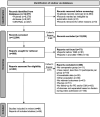Risk factors for diabetes mellitus after acute pancreatitis: a systematic review and meta-analysis
- PMID: 38264039
- PMCID: PMC10803425
- DOI: 10.3389/fmed.2023.1257222
Risk factors for diabetes mellitus after acute pancreatitis: a systematic review and meta-analysis
Abstract
Introduction: Within 5 years of having acute pancreatitis (AP), approximately 20% of patients develop diabetes mellitus (DM), which later increases to approximately 40%. Some studies suggest that the prevalence of prediabetes (PD) and/or DM can grow as high as 59% over time. However, information on risk factors is limited. We aimed to identify risk factors for developing PD or DM following AP.
Methods: We systematically searched three databases up to 4 September 2023 extracting direct, within-study comparisons of risk factors on the rate of new-onset PD and DM in AP patients. When PD and DM event rates could not be separated, we reported results for this composite outcome as PD/DM. Meta-analysis was performed using the random-effects model to calculate pooled odds ratios (OR) with 95% confidence intervals (CI).
Results: Of the 61 studies identified, 50 were included in the meta-analysis, covering 76,797 participants. The studies reported on 79 risk factors, and meta-analysis was feasible for 34 risk factor and outcome pairs. The odds of developing PD/DM was significantly higher after severe and moderately severe AP (OR: 4.32; CI: 1.76-10.60) than mild AP. Hypertriglyceridemic AP etiology (OR: 3.27; CI: 0.17-63.91) and pancreatic necrosis (OR: 5.53; CI: 1.59-19.21) were associated with a higher risk of developing PD/DM. Alcoholic AP etiology (OR: 1.82; CI: 1.09-3.04), organ failure (OR: 3.19; CI: 0.55-18.64), recurrent AP (OR: 1.89; CI: 0.95-3.77), obesity (OR: 1.85; CI: 1.43-2.38), chronic kidney disease (OR: 2.10; CI: 1.85-2.38), liver cirrhosis (OR: 2.48; CI: 0.18-34.25), and dyslipidemia (OR: 1.82; CI: 0.68-4.84) were associated with a higher risk of developing DM.
Discussion: Severe and moderately severe AP, alcoholic and hypertriglyceridemic etiologies, pancreatic necrosis, organ failure, recurrent acute pancreatitis and comorbidities of obesity, chronic kidney disease liver disease, and dyslipidemia are associated with a higher risk of developing PD or DM.
Systematic review registration: https://www.crd.york.ac.uk/prospero/, identifier CRD42021281983.
Keywords: acute pancreatitis (AP); diabetes mellitus; gastrointestinal disorders; pancreatitis—complications; prediabetes; risk factor (RF).
Copyright © 2024 Zahariev, Bunduc, Kovács, Demeter, Havelda, Budai, Veres, Hosszúfalusi, Erőss, Teutsch, Juhász and Hegyi.
Conflict of interest statement
The authors declare that the research was conducted in the absence of any commercial or financial relationships that could be construed as a potential conflict of interest. The author(s) declared that they were an editorial board member of Frontiers, at the time of submission. This had no impact on the peer review process and the final decision.
Figures







Similar articles
-
Incidence of New Onset Diabetes Mellitus Secondary to Acute Pancreatitis: A Systematic Review and Meta-Analysis.Front Physiol. 2019 May 31;10:637. doi: 10.3389/fphys.2019.00637. eCollection 2019. Front Physiol. 2019. PMID: 31231233 Free PMC article.
-
Identification of a Risk Profile for New-Onset Diabetes After Acute Pancreatitis.Pancreas. 2021 May-Jun 01;50(5):696-703. doi: 10.1097/MPA.0000000000001818. Pancreas. 2021. PMID: 34016890 Free PMC article.
-
Preexisting Diabetes Elevates Risk of Local and Systemic Complications in Acute Pancreatitis: Systematic Review and Meta-analysis.Pancreas. 2018 Sep;47(8):917-923. doi: 10.1097/MPA.0000000000001122. Pancreas. 2018. PMID: 30113426 Free PMC article.
-
Impaired glucose tolerance in acute pancreatitis.World J Gastroenterol. 2015 Jun 28;21(24):7367-74. doi: 10.3748/wjg.v21.i24.7367. World J Gastroenterol. 2015. PMID: 26139984 Free PMC article. Review.
-
Effect of the disease severity on the risk of developing new-onset diabetes after acute pancreatitis.Medicine (Baltimore). 2018 Jun;97(22):e10713. doi: 10.1097/MD.0000000000010713. Medicine (Baltimore). 2018. PMID: 29851776 Free PMC article.
Cited by
-
Impact of Serum Glucose Levels on Outcomes in Acute Pancreatitis: A Retrospective Analysis.Medicina (Kaunas). 2024 May 24;60(6):856. doi: 10.3390/medicina60060856. Medicina (Kaunas). 2024. PMID: 38929473 Free PMC article.
-
Risk and factors determining diabetes after mild, nonnecrotizing acute pancreatitis.Curr Opin Gastroenterol. 2024 Sep 1;40(5):396-403. doi: 10.1097/MOG.0000000000001055. Epub 2024 Jun 26. Curr Opin Gastroenterol. 2024. PMID: 38935336 Free PMC article. Review.
-
Hypertriglyceridemia-Induced and Alcohol-Induced Acute Pancreatitis-A Severity Comparative Study.Diagnostics (Basel). 2025 Apr 1;15(7):882. doi: 10.3390/diagnostics15070882. Diagnostics (Basel). 2025. PMID: 40218233 Free PMC article.
-
Risk Factors and Mechanisms for Diabetes in Pancreatitis.Gastroenterol Clin North Am. 2025 Mar;54(1):175-188. doi: 10.1016/j.gtc.2024.08.002. Epub 2024 Sep 10. Gastroenterol Clin North Am. 2025. PMID: 39880526 Review.
References
-
- Nagy A, Juhász MF, Görbe A, Váradi A, Izbéki F, Vincze Á, et al. . Glucose levels show independent and dose-dependent association with worsening acute pancreatitis outcomes: post-hoc analysis of a prospective, international cohort of 2250 acute pancreatitis cases. Pancreatology. (2021) 21:1237–46. doi: 10.1016/j.pan.2021.06.003, PMID: - DOI - PubMed
-
- Tu X, Liu Q, Chen L, Li J, Yu X, Jiao X, et al. . Number of recurrences is significantly associated with the post-acute pancreatitis diabetes mellitus in a population with hypertriglyceridemic acute pancreatitis. Lipids Health Dis. (2023) 22:82. doi: 10.1186/s12944-023-01840-0, PMID: - DOI - PMC - PubMed
Publication types
LinkOut - more resources
Full Text Sources

